Environmental Issues in the Neighbourhood of MEDWAY
VerifiedAdded on 2023/06/12
|10
|3657
|190
AI Summary
This essay focuses on the positive and negative influence of the neighbourhood on the individual’s health as well as the interventions that are in place to confront the identified issues so as to reduce the inequalities in health and enhance individual’s health in neighbourhood. The essay identifies and assesses assets which may either enhance health or influence well-being in a specific environment. The subject is Health Studies and the course code is not mentioned. The college/university is not mentioned.
Contribute Materials
Your contribution can guide someone’s learning journey. Share your
documents today.
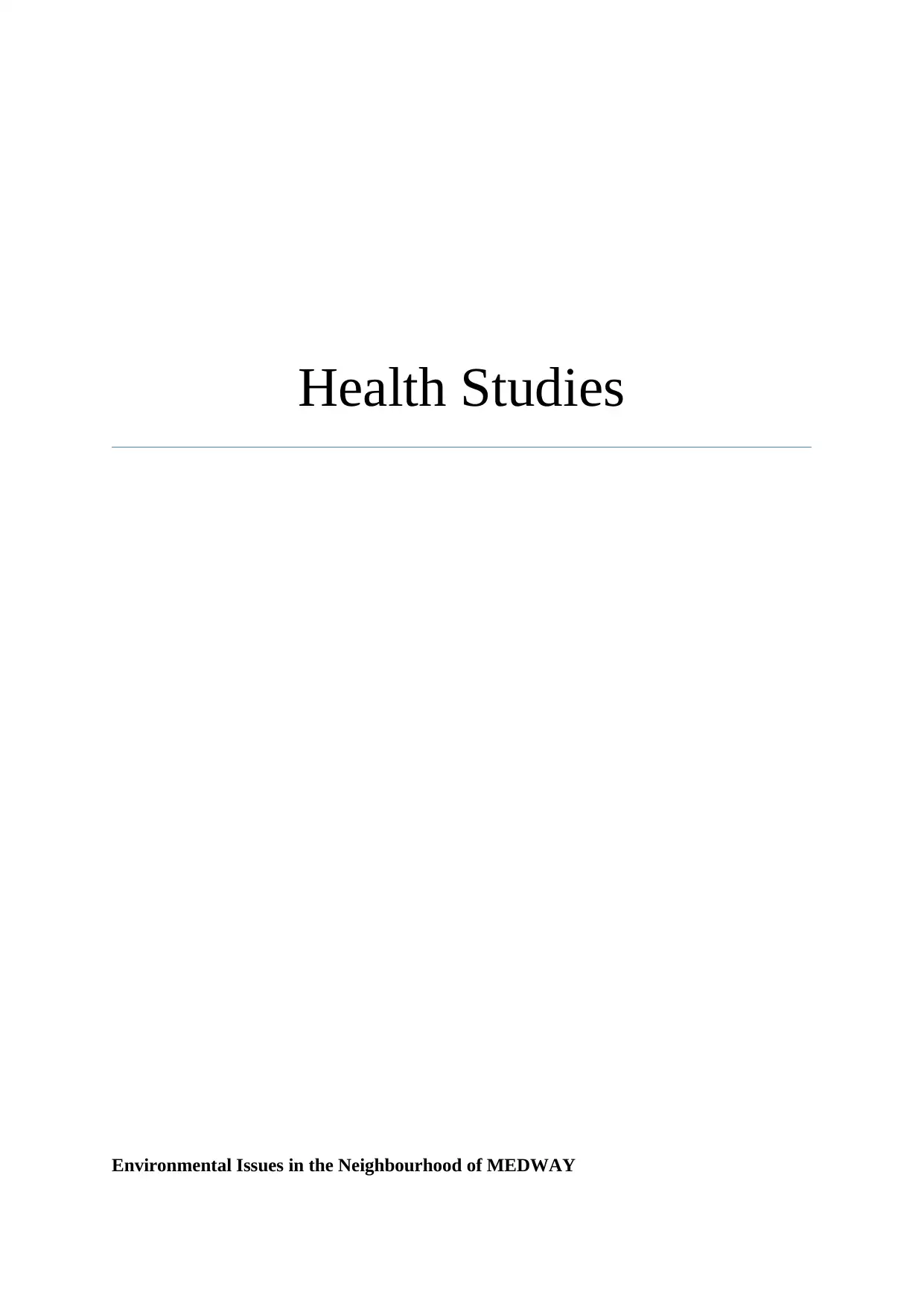
Health Studies
Environmental Issues in the Neighbourhood of MEDWAY
Environmental Issues in the Neighbourhood of MEDWAY
Secure Best Marks with AI Grader
Need help grading? Try our AI Grader for instant feedback on your assignments.
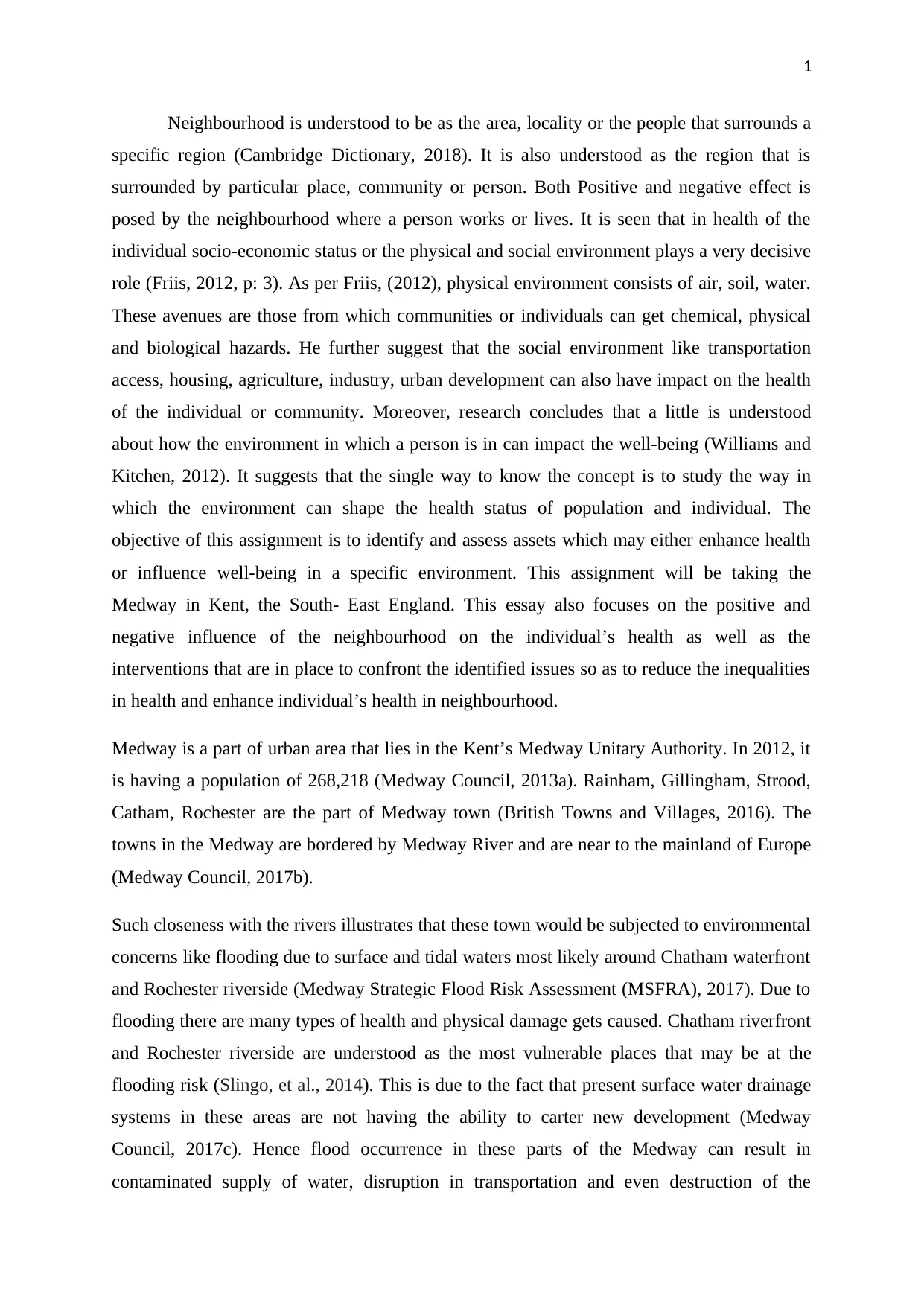
1
Neighbourhood is understood to be as the area, locality or the people that surrounds a
specific region (Cambridge Dictionary, 2018). It is also understood as the region that is
surrounded by particular place, community or person. Both Positive and negative effect is
posed by the neighbourhood where a person works or lives. It is seen that in health of the
individual socio-economic status or the physical and social environment plays a very decisive
role (Friis, 2012, p: 3). As per Friis, (2012), physical environment consists of air, soil, water.
These avenues are those from which communities or individuals can get chemical, physical
and biological hazards. He further suggest that the social environment like transportation
access, housing, agriculture, industry, urban development can also have impact on the health
of the individual or community. Moreover, research concludes that a little is understood
about how the environment in which a person is in can impact the well-being (Williams and
Kitchen, 2012). It suggests that the single way to know the concept is to study the way in
which the environment can shape the health status of population and individual. The
objective of this assignment is to identify and assess assets which may either enhance health
or influence well-being in a specific environment. This assignment will be taking the
Medway in Kent, the South- East England. This essay also focuses on the positive and
negative influence of the neighbourhood on the individual’s health as well as the
interventions that are in place to confront the identified issues so as to reduce the inequalities
in health and enhance individual’s health in neighbourhood.
Medway is a part of urban area that lies in the Kent’s Medway Unitary Authority. In 2012, it
is having a population of 268,218 (Medway Council, 2013a). Rainham, Gillingham, Strood,
Catham, Rochester are the part of Medway town (British Towns and Villages, 2016). The
towns in the Medway are bordered by Medway River and are near to the mainland of Europe
(Medway Council, 2017b).
Such closeness with the rivers illustrates that these town would be subjected to environmental
concerns like flooding due to surface and tidal waters most likely around Chatham waterfront
and Rochester riverside (Medway Strategic Flood Risk Assessment (MSFRA), 2017). Due to
flooding there are many types of health and physical damage gets caused. Chatham riverfront
and Rochester riverside are understood as the most vulnerable places that may be at the
flooding risk (Slingo, et al., 2014). This is due to the fact that present surface water drainage
systems in these areas are not having the ability to carter new development (Medway
Council, 2017c). Hence flood occurrence in these parts of the Medway can result in
contaminated supply of water, disruption in transportation and even destruction of the
Neighbourhood is understood to be as the area, locality or the people that surrounds a
specific region (Cambridge Dictionary, 2018). It is also understood as the region that is
surrounded by particular place, community or person. Both Positive and negative effect is
posed by the neighbourhood where a person works or lives. It is seen that in health of the
individual socio-economic status or the physical and social environment plays a very decisive
role (Friis, 2012, p: 3). As per Friis, (2012), physical environment consists of air, soil, water.
These avenues are those from which communities or individuals can get chemical, physical
and biological hazards. He further suggest that the social environment like transportation
access, housing, agriculture, industry, urban development can also have impact on the health
of the individual or community. Moreover, research concludes that a little is understood
about how the environment in which a person is in can impact the well-being (Williams and
Kitchen, 2012). It suggests that the single way to know the concept is to study the way in
which the environment can shape the health status of population and individual. The
objective of this assignment is to identify and assess assets which may either enhance health
or influence well-being in a specific environment. This assignment will be taking the
Medway in Kent, the South- East England. This essay also focuses on the positive and
negative influence of the neighbourhood on the individual’s health as well as the
interventions that are in place to confront the identified issues so as to reduce the inequalities
in health and enhance individual’s health in neighbourhood.
Medway is a part of urban area that lies in the Kent’s Medway Unitary Authority. In 2012, it
is having a population of 268,218 (Medway Council, 2013a). Rainham, Gillingham, Strood,
Catham, Rochester are the part of Medway town (British Towns and Villages, 2016). The
towns in the Medway are bordered by Medway River and are near to the mainland of Europe
(Medway Council, 2017b).
Such closeness with the rivers illustrates that these town would be subjected to environmental
concerns like flooding due to surface and tidal waters most likely around Chatham waterfront
and Rochester riverside (Medway Strategic Flood Risk Assessment (MSFRA), 2017). Due to
flooding there are many types of health and physical damage gets caused. Chatham riverfront
and Rochester riverside are understood as the most vulnerable places that may be at the
flooding risk (Slingo, et al., 2014). This is due to the fact that present surface water drainage
systems in these areas are not having the ability to carter new development (Medway
Council, 2017c). Hence flood occurrence in these parts of the Medway can result in
contaminated supply of water, disruption in transportation and even destruction of the
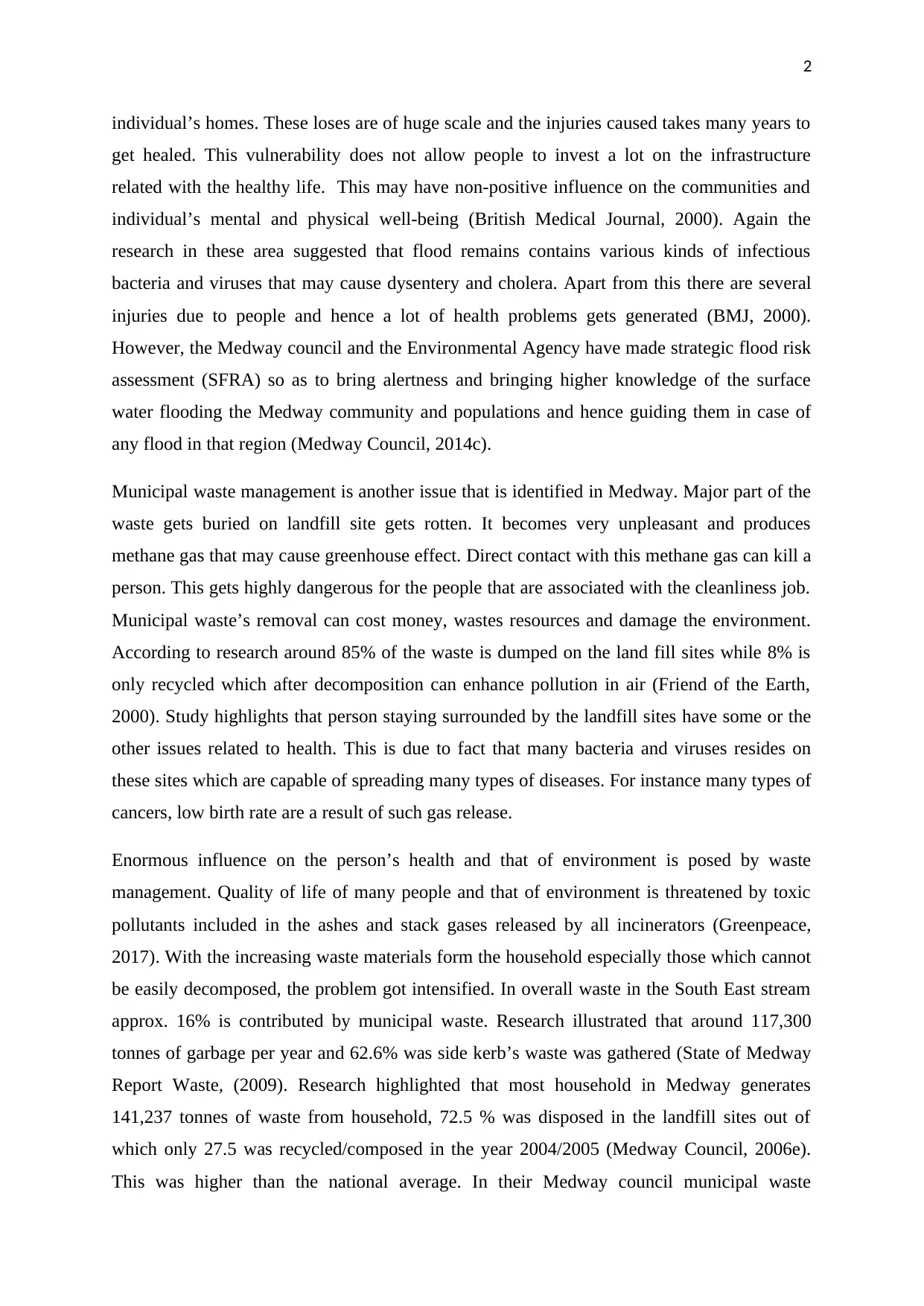
2
individual’s homes. These loses are of huge scale and the injuries caused takes many years to
get healed. This vulnerability does not allow people to invest a lot on the infrastructure
related with the healthy life. This may have non-positive influence on the communities and
individual’s mental and physical well-being (British Medical Journal, 2000). Again the
research in these area suggested that flood remains contains various kinds of infectious
bacteria and viruses that may cause dysentery and cholera. Apart from this there are several
injuries due to people and hence a lot of health problems gets generated (BMJ, 2000).
However, the Medway council and the Environmental Agency have made strategic flood risk
assessment (SFRA) so as to bring alertness and bringing higher knowledge of the surface
water flooding the Medway community and populations and hence guiding them in case of
any flood in that region (Medway Council, 2014c).
Municipal waste management is another issue that is identified in Medway. Major part of the
waste gets buried on landfill site gets rotten. It becomes very unpleasant and produces
methane gas that may cause greenhouse effect. Direct contact with this methane gas can kill a
person. This gets highly dangerous for the people that are associated with the cleanliness job.
Municipal waste’s removal can cost money, wastes resources and damage the environment.
According to research around 85% of the waste is dumped on the land fill sites while 8% is
only recycled which after decomposition can enhance pollution in air (Friend of the Earth,
2000). Study highlights that person staying surrounded by the landfill sites have some or the
other issues related to health. This is due to fact that many bacteria and viruses resides on
these sites which are capable of spreading many types of diseases. For instance many types of
cancers, low birth rate are a result of such gas release.
Enormous influence on the person’s health and that of environment is posed by waste
management. Quality of life of many people and that of environment is threatened by toxic
pollutants included in the ashes and stack gases released by all incinerators (Greenpeace,
2017). With the increasing waste materials form the household especially those which cannot
be easily decomposed, the problem got intensified. In overall waste in the South East stream
approx. 16% is contributed by municipal waste. Research illustrated that around 117,300
tonnes of garbage per year and 62.6% was side kerb’s waste was gathered (State of Medway
Report Waste, (2009). Research highlighted that most household in Medway generates
141,237 tonnes of waste from household, 72.5 % was disposed in the landfill sites out of
which only 27.5 was recycled/composed in the year 2004/2005 (Medway Council, 2006e).
This was higher than the national average. In their Medway council municipal waste
individual’s homes. These loses are of huge scale and the injuries caused takes many years to
get healed. This vulnerability does not allow people to invest a lot on the infrastructure
related with the healthy life. This may have non-positive influence on the communities and
individual’s mental and physical well-being (British Medical Journal, 2000). Again the
research in these area suggested that flood remains contains various kinds of infectious
bacteria and viruses that may cause dysentery and cholera. Apart from this there are several
injuries due to people and hence a lot of health problems gets generated (BMJ, 2000).
However, the Medway council and the Environmental Agency have made strategic flood risk
assessment (SFRA) so as to bring alertness and bringing higher knowledge of the surface
water flooding the Medway community and populations and hence guiding them in case of
any flood in that region (Medway Council, 2014c).
Municipal waste management is another issue that is identified in Medway. Major part of the
waste gets buried on landfill site gets rotten. It becomes very unpleasant and produces
methane gas that may cause greenhouse effect. Direct contact with this methane gas can kill a
person. This gets highly dangerous for the people that are associated with the cleanliness job.
Municipal waste’s removal can cost money, wastes resources and damage the environment.
According to research around 85% of the waste is dumped on the land fill sites while 8% is
only recycled which after decomposition can enhance pollution in air (Friend of the Earth,
2000). Study highlights that person staying surrounded by the landfill sites have some or the
other issues related to health. This is due to fact that many bacteria and viruses resides on
these sites which are capable of spreading many types of diseases. For instance many types of
cancers, low birth rate are a result of such gas release.
Enormous influence on the person’s health and that of environment is posed by waste
management. Quality of life of many people and that of environment is threatened by toxic
pollutants included in the ashes and stack gases released by all incinerators (Greenpeace,
2017). With the increasing waste materials form the household especially those which cannot
be easily decomposed, the problem got intensified. In overall waste in the South East stream
approx. 16% is contributed by municipal waste. Research illustrated that around 117,300
tonnes of garbage per year and 62.6% was side kerb’s waste was gathered (State of Medway
Report Waste, (2009). Research highlighted that most household in Medway generates
141,237 tonnes of waste from household, 72.5 % was disposed in the landfill sites out of
which only 27.5 was recycled/composed in the year 2004/2005 (Medway Council, 2006e).
This was higher than the national average. In their Medway council municipal waste
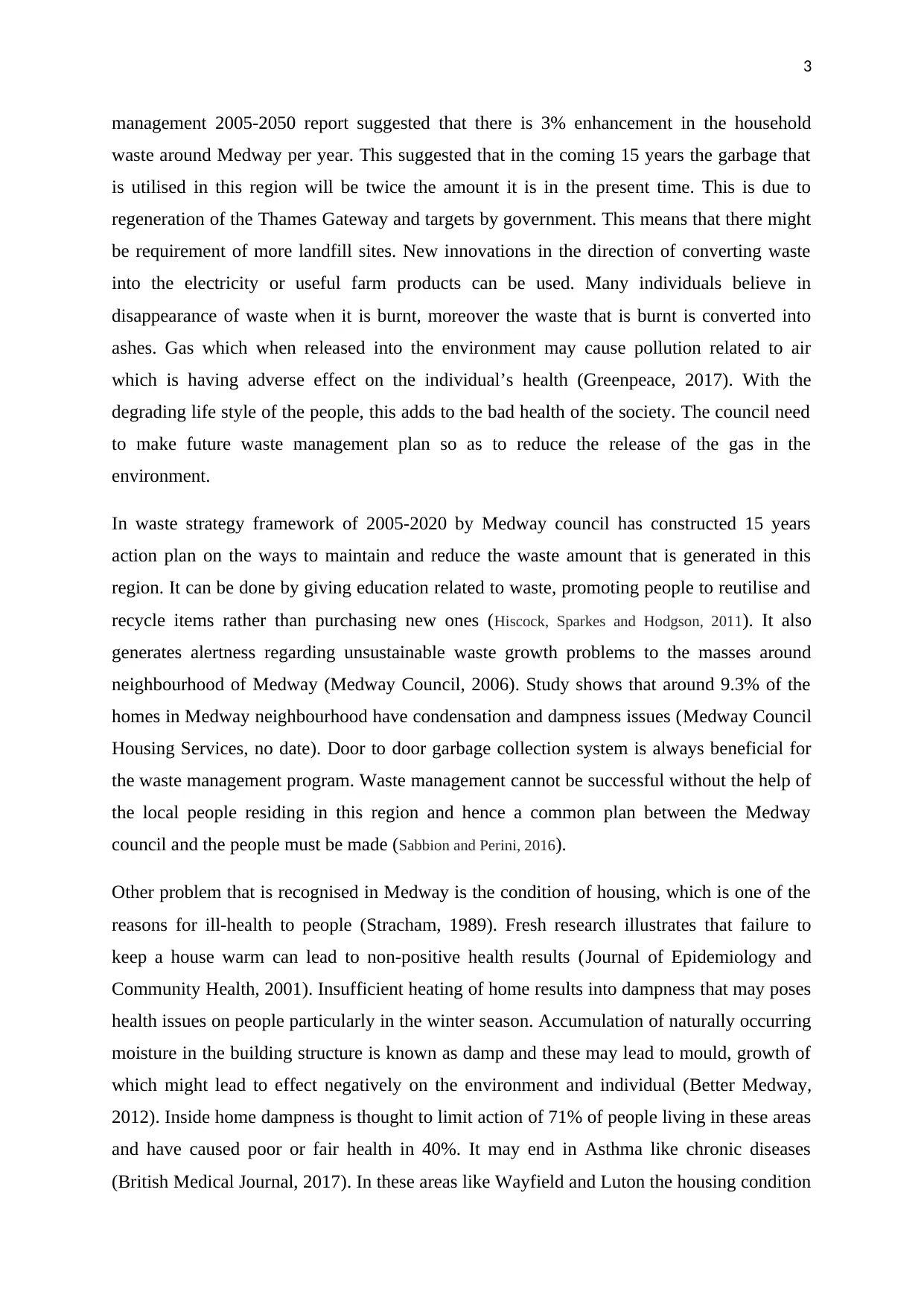
3
management 2005-2050 report suggested that there is 3% enhancement in the household
waste around Medway per year. This suggested that in the coming 15 years the garbage that
is utilised in this region will be twice the amount it is in the present time. This is due to
regeneration of the Thames Gateway and targets by government. This means that there might
be requirement of more landfill sites. New innovations in the direction of converting waste
into the electricity or useful farm products can be used. Many individuals believe in
disappearance of waste when it is burnt, moreover the waste that is burnt is converted into
ashes. Gas which when released into the environment may cause pollution related to air
which is having adverse effect on the individual’s health (Greenpeace, 2017). With the
degrading life style of the people, this adds to the bad health of the society. The council need
to make future waste management plan so as to reduce the release of the gas in the
environment.
In waste strategy framework of 2005-2020 by Medway council has constructed 15 years
action plan on the ways to maintain and reduce the waste amount that is generated in this
region. It can be done by giving education related to waste, promoting people to reutilise and
recycle items rather than purchasing new ones (Hiscock, Sparkes and Hodgson, 2011). It also
generates alertness regarding unsustainable waste growth problems to the masses around
neighbourhood of Medway (Medway Council, 2006). Study shows that around 9.3% of the
homes in Medway neighbourhood have condensation and dampness issues (Medway Council
Housing Services, no date). Door to door garbage collection system is always beneficial for
the waste management program. Waste management cannot be successful without the help of
the local people residing in this region and hence a common plan between the Medway
council and the people must be made (Sabbion and Perini, 2016).
Other problem that is recognised in Medway is the condition of housing, which is one of the
reasons for ill-health to people (Stracham, 1989). Fresh research illustrates that failure to
keep a house warm can lead to non-positive health results (Journal of Epidemiology and
Community Health, 2001). Insufficient heating of home results into dampness that may poses
health issues on people particularly in the winter season. Accumulation of naturally occurring
moisture in the building structure is known as damp and these may lead to mould, growth of
which might lead to effect negatively on the environment and individual (Better Medway,
2012). Inside home dampness is thought to limit action of 71% of people living in these areas
and have caused poor or fair health in 40%. It may end in Asthma like chronic diseases
(British Medical Journal, 2017). In these areas like Wayfield and Luton the housing condition
management 2005-2050 report suggested that there is 3% enhancement in the household
waste around Medway per year. This suggested that in the coming 15 years the garbage that
is utilised in this region will be twice the amount it is in the present time. This is due to
regeneration of the Thames Gateway and targets by government. This means that there might
be requirement of more landfill sites. New innovations in the direction of converting waste
into the electricity or useful farm products can be used. Many individuals believe in
disappearance of waste when it is burnt, moreover the waste that is burnt is converted into
ashes. Gas which when released into the environment may cause pollution related to air
which is having adverse effect on the individual’s health (Greenpeace, 2017). With the
degrading life style of the people, this adds to the bad health of the society. The council need
to make future waste management plan so as to reduce the release of the gas in the
environment.
In waste strategy framework of 2005-2020 by Medway council has constructed 15 years
action plan on the ways to maintain and reduce the waste amount that is generated in this
region. It can be done by giving education related to waste, promoting people to reutilise and
recycle items rather than purchasing new ones (Hiscock, Sparkes and Hodgson, 2011). It also
generates alertness regarding unsustainable waste growth problems to the masses around
neighbourhood of Medway (Medway Council, 2006). Study shows that around 9.3% of the
homes in Medway neighbourhood have condensation and dampness issues (Medway Council
Housing Services, no date). Door to door garbage collection system is always beneficial for
the waste management program. Waste management cannot be successful without the help of
the local people residing in this region and hence a common plan between the Medway
council and the people must be made (Sabbion and Perini, 2016).
Other problem that is recognised in Medway is the condition of housing, which is one of the
reasons for ill-health to people (Stracham, 1989). Fresh research illustrates that failure to
keep a house warm can lead to non-positive health results (Journal of Epidemiology and
Community Health, 2001). Insufficient heating of home results into dampness that may poses
health issues on people particularly in the winter season. Accumulation of naturally occurring
moisture in the building structure is known as damp and these may lead to mould, growth of
which might lead to effect negatively on the environment and individual (Better Medway,
2012). Inside home dampness is thought to limit action of 71% of people living in these areas
and have caused poor or fair health in 40%. It may end in Asthma like chronic diseases
(British Medical Journal, 2017). In these areas like Wayfield and Luton the housing condition
Secure Best Marks with AI Grader
Need help grading? Try our AI Grader for instant feedback on your assignments.
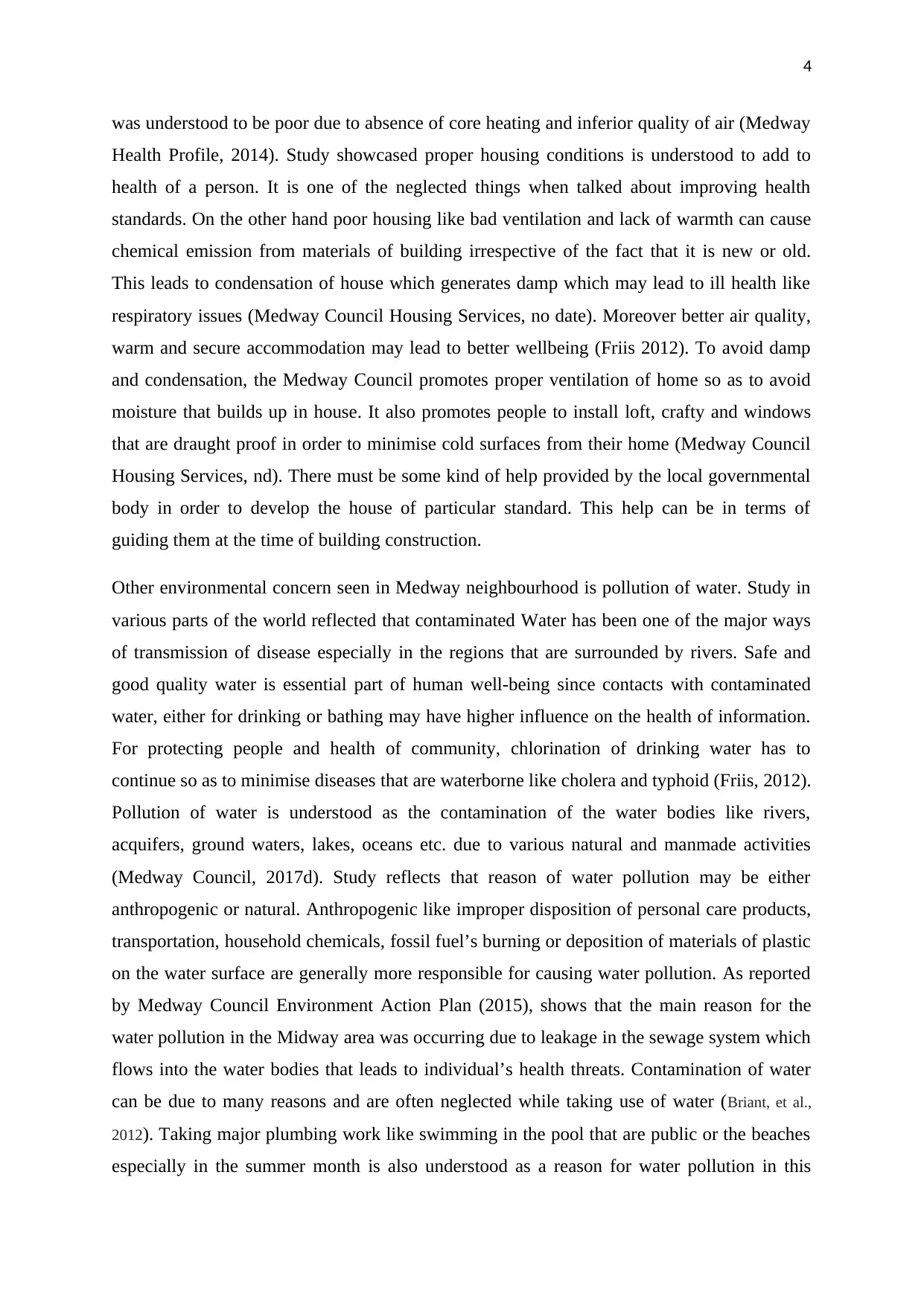
4
was understood to be poor due to absence of core heating and inferior quality of air (Medway
Health Profile, 2014). Study showcased proper housing conditions is understood to add to
health of a person. It is one of the neglected things when talked about improving health
standards. On the other hand poor housing like bad ventilation and lack of warmth can cause
chemical emission from materials of building irrespective of the fact that it is new or old.
This leads to condensation of house which generates damp which may lead to ill health like
respiratory issues (Medway Council Housing Services, no date). Moreover better air quality,
warm and secure accommodation may lead to better wellbeing (Friis 2012). To avoid damp
and condensation, the Medway Council promotes proper ventilation of home so as to avoid
moisture that builds up in house. It also promotes people to install loft, crafty and windows
that are draught proof in order to minimise cold surfaces from their home (Medway Council
Housing Services, nd). There must be some kind of help provided by the local governmental
body in order to develop the house of particular standard. This help can be in terms of
guiding them at the time of building construction.
Other environmental concern seen in Medway neighbourhood is pollution of water. Study in
various parts of the world reflected that contaminated Water has been one of the major ways
of transmission of disease especially in the regions that are surrounded by rivers. Safe and
good quality water is essential part of human well-being since contacts with contaminated
water, either for drinking or bathing may have higher influence on the health of information.
For protecting people and health of community, chlorination of drinking water has to
continue so as to minimise diseases that are waterborne like cholera and typhoid (Friis, 2012).
Pollution of water is understood as the contamination of the water bodies like rivers,
acquifers, ground waters, lakes, oceans etc. due to various natural and manmade activities
(Medway Council, 2017d). Study reflects that reason of water pollution may be either
anthropogenic or natural. Anthropogenic like improper disposition of personal care products,
transportation, household chemicals, fossil fuel’s burning or deposition of materials of plastic
on the water surface are generally more responsible for causing water pollution. As reported
by Medway Council Environment Action Plan (2015), shows that the main reason for the
water pollution in the Midway area was occurring due to leakage in the sewage system which
flows into the water bodies that leads to individual’s health threats. Contamination of water
can be due to many reasons and are often neglected while taking use of water (Briant, et al.,
2012). Taking major plumbing work like swimming in the pool that are public or the beaches
especially in the summer month is also understood as a reason for water pollution in this
was understood to be poor due to absence of core heating and inferior quality of air (Medway
Health Profile, 2014). Study showcased proper housing conditions is understood to add to
health of a person. It is one of the neglected things when talked about improving health
standards. On the other hand poor housing like bad ventilation and lack of warmth can cause
chemical emission from materials of building irrespective of the fact that it is new or old.
This leads to condensation of house which generates damp which may lead to ill health like
respiratory issues (Medway Council Housing Services, no date). Moreover better air quality,
warm and secure accommodation may lead to better wellbeing (Friis 2012). To avoid damp
and condensation, the Medway Council promotes proper ventilation of home so as to avoid
moisture that builds up in house. It also promotes people to install loft, crafty and windows
that are draught proof in order to minimise cold surfaces from their home (Medway Council
Housing Services, nd). There must be some kind of help provided by the local governmental
body in order to develop the house of particular standard. This help can be in terms of
guiding them at the time of building construction.
Other environmental concern seen in Medway neighbourhood is pollution of water. Study in
various parts of the world reflected that contaminated Water has been one of the major ways
of transmission of disease especially in the regions that are surrounded by rivers. Safe and
good quality water is essential part of human well-being since contacts with contaminated
water, either for drinking or bathing may have higher influence on the health of information.
For protecting people and health of community, chlorination of drinking water has to
continue so as to minimise diseases that are waterborne like cholera and typhoid (Friis, 2012).
Pollution of water is understood as the contamination of the water bodies like rivers,
acquifers, ground waters, lakes, oceans etc. due to various natural and manmade activities
(Medway Council, 2017d). Study reflects that reason of water pollution may be either
anthropogenic or natural. Anthropogenic like improper disposition of personal care products,
transportation, household chemicals, fossil fuel’s burning or deposition of materials of plastic
on the water surface are generally more responsible for causing water pollution. As reported
by Medway Council Environment Action Plan (2015), shows that the main reason for the
water pollution in the Midway area was occurring due to leakage in the sewage system which
flows into the water bodies that leads to individual’s health threats. Contamination of water
can be due to many reasons and are often neglected while taking use of water (Briant, et al.,
2012). Taking major plumbing work like swimming in the pool that are public or the beaches
especially in the summer month is also understood as a reason for water pollution in this
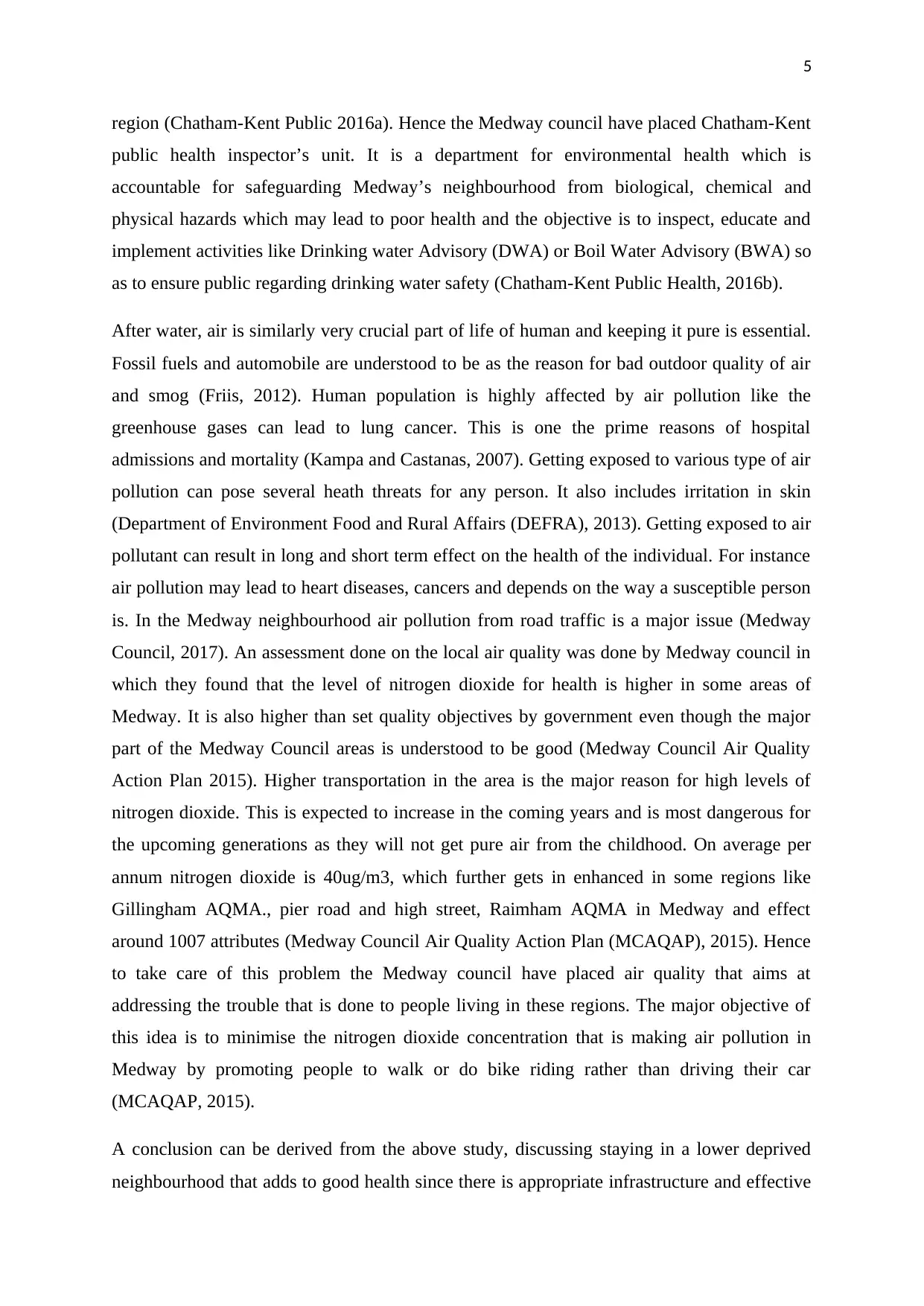
5
region (Chatham-Kent Public 2016a). Hence the Medway council have placed Chatham-Kent
public health inspector’s unit. It is a department for environmental health which is
accountable for safeguarding Medway’s neighbourhood from biological, chemical and
physical hazards which may lead to poor health and the objective is to inspect, educate and
implement activities like Drinking water Advisory (DWA) or Boil Water Advisory (BWA) so
as to ensure public regarding drinking water safety (Chatham-Kent Public Health, 2016b).
After water, air is similarly very crucial part of life of human and keeping it pure is essential.
Fossil fuels and automobile are understood to be as the reason for bad outdoor quality of air
and smog (Friis, 2012). Human population is highly affected by air pollution like the
greenhouse gases can lead to lung cancer. This is one the prime reasons of hospital
admissions and mortality (Kampa and Castanas, 2007). Getting exposed to various type of air
pollution can pose several heath threats for any person. It also includes irritation in skin
(Department of Environment Food and Rural Affairs (DEFRA), 2013). Getting exposed to air
pollutant can result in long and short term effect on the health of the individual. For instance
air pollution may lead to heart diseases, cancers and depends on the way a susceptible person
is. In the Medway neighbourhood air pollution from road traffic is a major issue (Medway
Council, 2017). An assessment done on the local air quality was done by Medway council in
which they found that the level of nitrogen dioxide for health is higher in some areas of
Medway. It is also higher than set quality objectives by government even though the major
part of the Medway Council areas is understood to be good (Medway Council Air Quality
Action Plan 2015). Higher transportation in the area is the major reason for high levels of
nitrogen dioxide. This is expected to increase in the coming years and is most dangerous for
the upcoming generations as they will not get pure air from the childhood. On average per
annum nitrogen dioxide is 40ug/m3, which further gets in enhanced in some regions like
Gillingham AQMA., pier road and high street, Raimham AQMA in Medway and effect
around 1007 attributes (Medway Council Air Quality Action Plan (MCAQAP), 2015). Hence
to take care of this problem the Medway council have placed air quality that aims at
addressing the trouble that is done to people living in these regions. The major objective of
this idea is to minimise the nitrogen dioxide concentration that is making air pollution in
Medway by promoting people to walk or do bike riding rather than driving their car
(MCAQAP, 2015).
A conclusion can be derived from the above study, discussing staying in a lower deprived
neighbourhood that adds to good health since there is appropriate infrastructure and effective
region (Chatham-Kent Public 2016a). Hence the Medway council have placed Chatham-Kent
public health inspector’s unit. It is a department for environmental health which is
accountable for safeguarding Medway’s neighbourhood from biological, chemical and
physical hazards which may lead to poor health and the objective is to inspect, educate and
implement activities like Drinking water Advisory (DWA) or Boil Water Advisory (BWA) so
as to ensure public regarding drinking water safety (Chatham-Kent Public Health, 2016b).
After water, air is similarly very crucial part of life of human and keeping it pure is essential.
Fossil fuels and automobile are understood to be as the reason for bad outdoor quality of air
and smog (Friis, 2012). Human population is highly affected by air pollution like the
greenhouse gases can lead to lung cancer. This is one the prime reasons of hospital
admissions and mortality (Kampa and Castanas, 2007). Getting exposed to various type of air
pollution can pose several heath threats for any person. It also includes irritation in skin
(Department of Environment Food and Rural Affairs (DEFRA), 2013). Getting exposed to air
pollutant can result in long and short term effect on the health of the individual. For instance
air pollution may lead to heart diseases, cancers and depends on the way a susceptible person
is. In the Medway neighbourhood air pollution from road traffic is a major issue (Medway
Council, 2017). An assessment done on the local air quality was done by Medway council in
which they found that the level of nitrogen dioxide for health is higher in some areas of
Medway. It is also higher than set quality objectives by government even though the major
part of the Medway Council areas is understood to be good (Medway Council Air Quality
Action Plan 2015). Higher transportation in the area is the major reason for high levels of
nitrogen dioxide. This is expected to increase in the coming years and is most dangerous for
the upcoming generations as they will not get pure air from the childhood. On average per
annum nitrogen dioxide is 40ug/m3, which further gets in enhanced in some regions like
Gillingham AQMA., pier road and high street, Raimham AQMA in Medway and effect
around 1007 attributes (Medway Council Air Quality Action Plan (MCAQAP), 2015). Hence
to take care of this problem the Medway council have placed air quality that aims at
addressing the trouble that is done to people living in these regions. The major objective of
this idea is to minimise the nitrogen dioxide concentration that is making air pollution in
Medway by promoting people to walk or do bike riding rather than driving their car
(MCAQAP, 2015).
A conclusion can be derived from the above study, discussing staying in a lower deprived
neighbourhood that adds to good health since there is appropriate infrastructure and effective
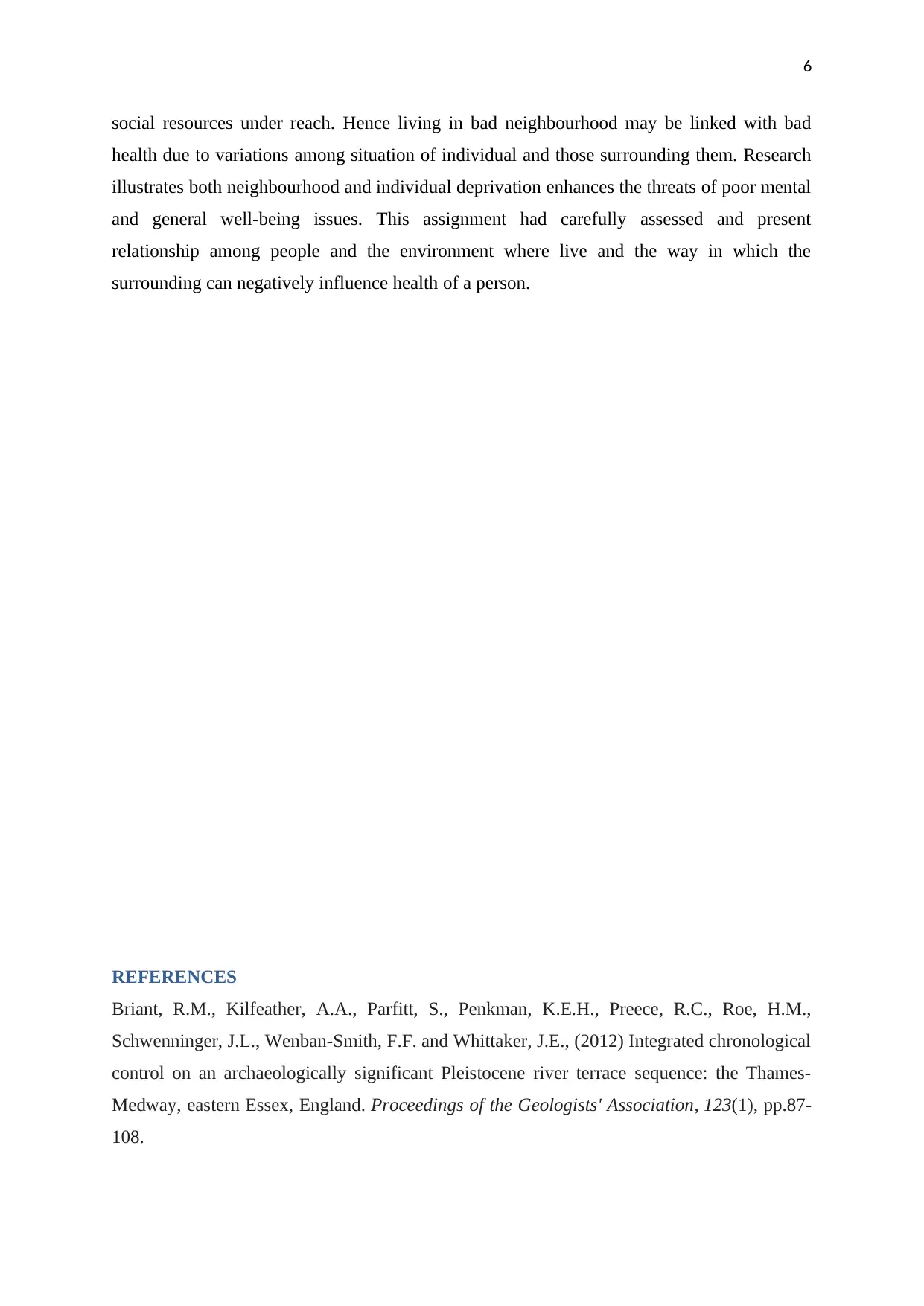
6
social resources under reach. Hence living in bad neighbourhood may be linked with bad
health due to variations among situation of individual and those surrounding them. Research
illustrates both neighbourhood and individual deprivation enhances the threats of poor mental
and general well-being issues. This assignment had carefully assessed and present
relationship among people and the environment where live and the way in which the
surrounding can negatively influence health of a person.
REFERENCES
Briant, R.M., Kilfeather, A.A., Parfitt, S., Penkman, K.E.H., Preece, R.C., Roe, H.M.,
Schwenninger, J.L., Wenban-Smith, F.F. and Whittaker, J.E., (2012) Integrated chronological
control on an archaeologically significant Pleistocene river terrace sequence: the Thames-
Medway, eastern Essex, England. Proceedings of the Geologists' Association, 123(1), pp.87-
108.
social resources under reach. Hence living in bad neighbourhood may be linked with bad
health due to variations among situation of individual and those surrounding them. Research
illustrates both neighbourhood and individual deprivation enhances the threats of poor mental
and general well-being issues. This assignment had carefully assessed and present
relationship among people and the environment where live and the way in which the
surrounding can negatively influence health of a person.
REFERENCES
Briant, R.M., Kilfeather, A.A., Parfitt, S., Penkman, K.E.H., Preece, R.C., Roe, H.M.,
Schwenninger, J.L., Wenban-Smith, F.F. and Whittaker, J.E., (2012) Integrated chronological
control on an archaeologically significant Pleistocene river terrace sequence: the Thames-
Medway, eastern Essex, England. Proceedings of the Geologists' Association, 123(1), pp.87-
108.
Paraphrase This Document
Need a fresh take? Get an instant paraphrase of this document with our AI Paraphraser
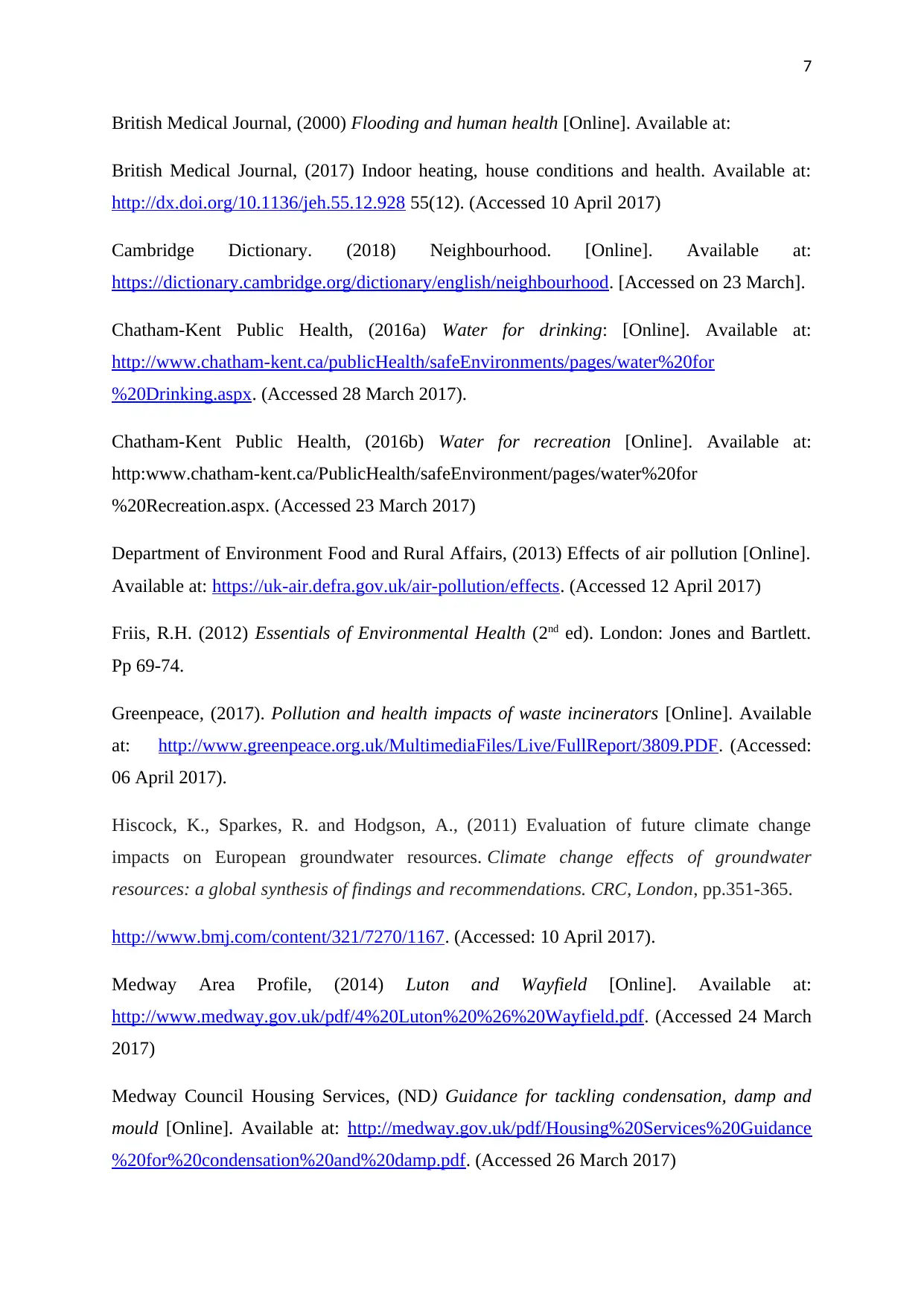
7
British Medical Journal, (2000) Flooding and human health [Online]. Available at:
British Medical Journal, (2017) Indoor heating, house conditions and health. Available at:
http://dx.doi.org/10.1136/jeh.55.12.928 55(12). (Accessed 10 April 2017)
Cambridge Dictionary. (2018) Neighbourhood. [Online]. Available at:
https://dictionary.cambridge.org/dictionary/english/neighbourhood. [Accessed on 23 March].
Chatham-Kent Public Health, (2016a) Water for drinking: [Online]. Available at:
http://www.chatham-kent.ca/publicHealth/safeEnvironments/pages/water%20for
%20Drinking.aspx. (Accessed 28 March 2017).
Chatham-Kent Public Health, (2016b) Water for recreation [Online]. Available at:
http:www.chatham-kent.ca/PublicHealth/safeEnvironment/pages/water%20for
%20Recreation.aspx. (Accessed 23 March 2017)
Department of Environment Food and Rural Affairs, (2013) Effects of air pollution [Online].
Available at: https://uk-air.defra.gov.uk/air-pollution/effects. (Accessed 12 April 2017)
Friis, R.H. (2012) Essentials of Environmental Health (2nd ed). London: Jones and Bartlett.
Pp 69-74.
Greenpeace, (2017). Pollution and health impacts of waste incinerators [Online]. Available
at: http://www.greenpeace.org.uk/MultimediaFiles/Live/FullReport/3809.PDF. (Accessed:
06 April 2017).
Hiscock, K., Sparkes, R. and Hodgson, A., (2011) Evaluation of future climate change
impacts on European groundwater resources. Climate change effects of groundwater
resources: a global synthesis of findings and recommendations. CRC, London, pp.351-365.
http://www.bmj.com/content/321/7270/1167. (Accessed: 10 April 2017).
Medway Area Profile, (2014) Luton and Wayfield [Online]. Available at:
http://www.medway.gov.uk/pdf/4%20Luton%20%26%20Wayfield.pdf. (Accessed 24 March
2017)
Medway Council Housing Services, (ND) Guidance for tackling condensation, damp and
mould [Online]. Available at: http://medway.gov.uk/pdf/Housing%20Services%20Guidance
%20for%20condensation%20and%20damp.pdf. (Accessed 26 March 2017)
British Medical Journal, (2000) Flooding and human health [Online]. Available at:
British Medical Journal, (2017) Indoor heating, house conditions and health. Available at:
http://dx.doi.org/10.1136/jeh.55.12.928 55(12). (Accessed 10 April 2017)
Cambridge Dictionary. (2018) Neighbourhood. [Online]. Available at:
https://dictionary.cambridge.org/dictionary/english/neighbourhood. [Accessed on 23 March].
Chatham-Kent Public Health, (2016a) Water for drinking: [Online]. Available at:
http://www.chatham-kent.ca/publicHealth/safeEnvironments/pages/water%20for
%20Drinking.aspx. (Accessed 28 March 2017).
Chatham-Kent Public Health, (2016b) Water for recreation [Online]. Available at:
http:www.chatham-kent.ca/PublicHealth/safeEnvironment/pages/water%20for
%20Recreation.aspx. (Accessed 23 March 2017)
Department of Environment Food and Rural Affairs, (2013) Effects of air pollution [Online].
Available at: https://uk-air.defra.gov.uk/air-pollution/effects. (Accessed 12 April 2017)
Friis, R.H. (2012) Essentials of Environmental Health (2nd ed). London: Jones and Bartlett.
Pp 69-74.
Greenpeace, (2017). Pollution and health impacts of waste incinerators [Online]. Available
at: http://www.greenpeace.org.uk/MultimediaFiles/Live/FullReport/3809.PDF. (Accessed:
06 April 2017).
Hiscock, K., Sparkes, R. and Hodgson, A., (2011) Evaluation of future climate change
impacts on European groundwater resources. Climate change effects of groundwater
resources: a global synthesis of findings and recommendations. CRC, London, pp.351-365.
http://www.bmj.com/content/321/7270/1167. (Accessed: 10 April 2017).
Medway Area Profile, (2014) Luton and Wayfield [Online]. Available at:
http://www.medway.gov.uk/pdf/4%20Luton%20%26%20Wayfield.pdf. (Accessed 24 March
2017)
Medway Council Housing Services, (ND) Guidance for tackling condensation, damp and
mould [Online]. Available at: http://medway.gov.uk/pdf/Housing%20Services%20Guidance
%20for%20condensation%20and%20damp.pdf. (Accessed 26 March 2017)
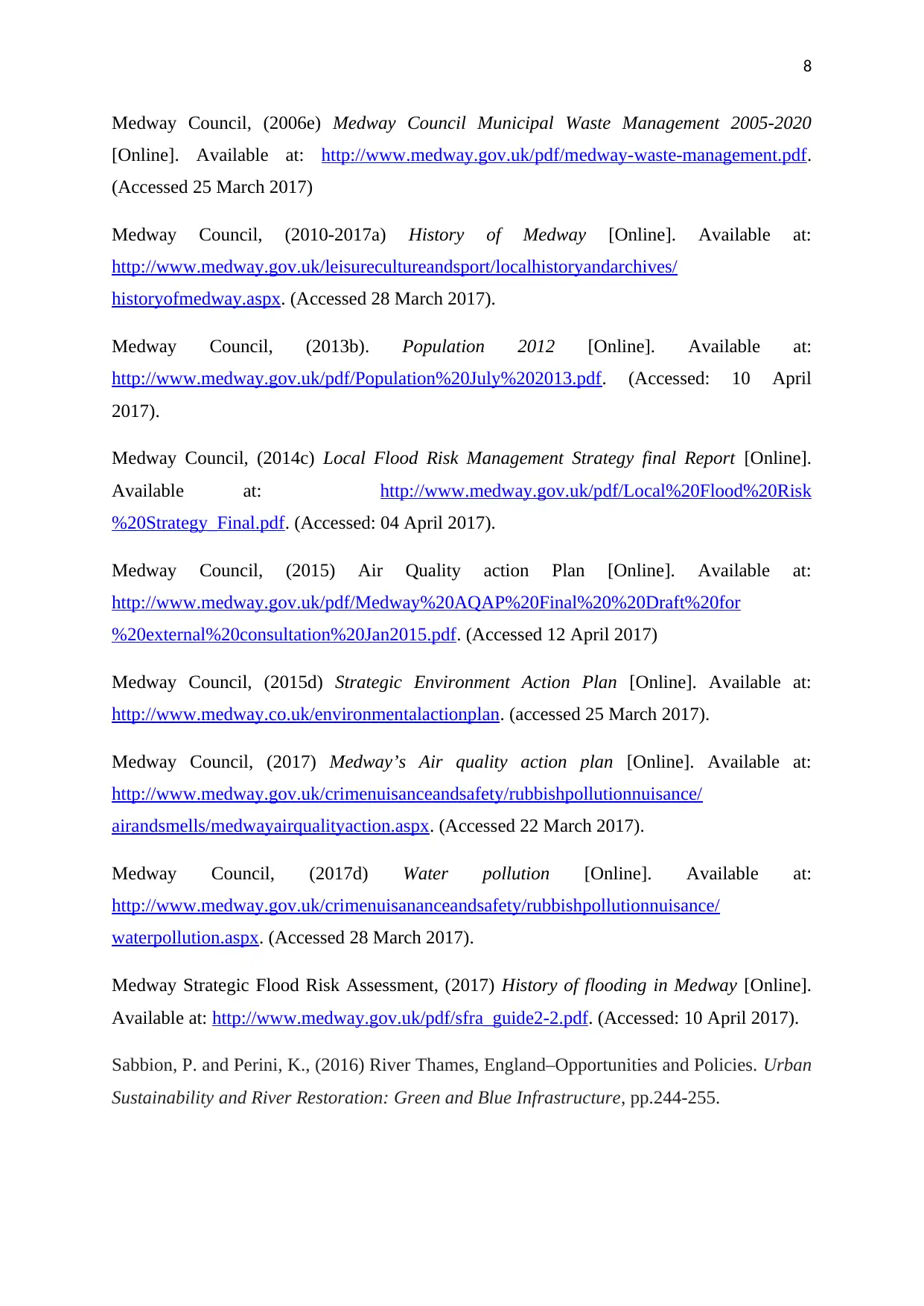
8
Medway Council, (2006e) Medway Council Municipal Waste Management 2005-2020
[Online]. Available at: http://www.medway.gov.uk/pdf/medway-waste-management.pdf.
(Accessed 25 March 2017)
Medway Council, (2010-2017a) History of Medway [Online]. Available at:
http://www.medway.gov.uk/leisurecultureandsport/localhistoryandarchives/
historyofmedway.aspx. (Accessed 28 March 2017).
Medway Council, (2013b). Population 2012 [Online]. Available at:
http://www.medway.gov.uk/pdf/Population%20July%202013.pdf. (Accessed: 10 April
2017).
Medway Council, (2014c) Local Flood Risk Management Strategy final Report [Online].
Available at: http://www.medway.gov.uk/pdf/Local%20Flood%20Risk
%20Strategy_Final.pdf. (Accessed: 04 April 2017).
Medway Council, (2015) Air Quality action Plan [Online]. Available at:
http://www.medway.gov.uk/pdf/Medway%20AQAP%20Final%20%20Draft%20for
%20external%20consultation%20Jan2015.pdf. (Accessed 12 April 2017)
Medway Council, (2015d) Strategic Environment Action Plan [Online]. Available at:
http://www.medway.co.uk/environmentalactionplan. (accessed 25 March 2017).
Medway Council, (2017) Medway’s Air quality action plan [Online]. Available at:
http://www.medway.gov.uk/crimenuisanceandsafety/rubbishpollutionnuisance/
airandsmells/medwayairqualityaction.aspx. (Accessed 22 March 2017).
Medway Council, (2017d) Water pollution [Online]. Available at:
http://www.medway.gov.uk/crimenuisananceandsafety/rubbishpollutionnuisance/
waterpollution.aspx. (Accessed 28 March 2017).
Medway Strategic Flood Risk Assessment, (2017) History of flooding in Medway [Online].
Available at: http://www.medway.gov.uk/pdf/sfra_guide2-2.pdf. (Accessed: 10 April 2017).
Sabbion, P. and Perini, K., (2016) River Thames, England–Opportunities and Policies. Urban
Sustainability and River Restoration: Green and Blue Infrastructure, pp.244-255.
Medway Council, (2006e) Medway Council Municipal Waste Management 2005-2020
[Online]. Available at: http://www.medway.gov.uk/pdf/medway-waste-management.pdf.
(Accessed 25 March 2017)
Medway Council, (2010-2017a) History of Medway [Online]. Available at:
http://www.medway.gov.uk/leisurecultureandsport/localhistoryandarchives/
historyofmedway.aspx. (Accessed 28 March 2017).
Medway Council, (2013b). Population 2012 [Online]. Available at:
http://www.medway.gov.uk/pdf/Population%20July%202013.pdf. (Accessed: 10 April
2017).
Medway Council, (2014c) Local Flood Risk Management Strategy final Report [Online].
Available at: http://www.medway.gov.uk/pdf/Local%20Flood%20Risk
%20Strategy_Final.pdf. (Accessed: 04 April 2017).
Medway Council, (2015) Air Quality action Plan [Online]. Available at:
http://www.medway.gov.uk/pdf/Medway%20AQAP%20Final%20%20Draft%20for
%20external%20consultation%20Jan2015.pdf. (Accessed 12 April 2017)
Medway Council, (2015d) Strategic Environment Action Plan [Online]. Available at:
http://www.medway.co.uk/environmentalactionplan. (accessed 25 March 2017).
Medway Council, (2017) Medway’s Air quality action plan [Online]. Available at:
http://www.medway.gov.uk/crimenuisanceandsafety/rubbishpollutionnuisance/
airandsmells/medwayairqualityaction.aspx. (Accessed 22 March 2017).
Medway Council, (2017d) Water pollution [Online]. Available at:
http://www.medway.gov.uk/crimenuisananceandsafety/rubbishpollutionnuisance/
waterpollution.aspx. (Accessed 28 March 2017).
Medway Strategic Flood Risk Assessment, (2017) History of flooding in Medway [Online].
Available at: http://www.medway.gov.uk/pdf/sfra_guide2-2.pdf. (Accessed: 10 April 2017).
Sabbion, P. and Perini, K., (2016) River Thames, England–Opportunities and Policies. Urban
Sustainability and River Restoration: Green and Blue Infrastructure, pp.244-255.
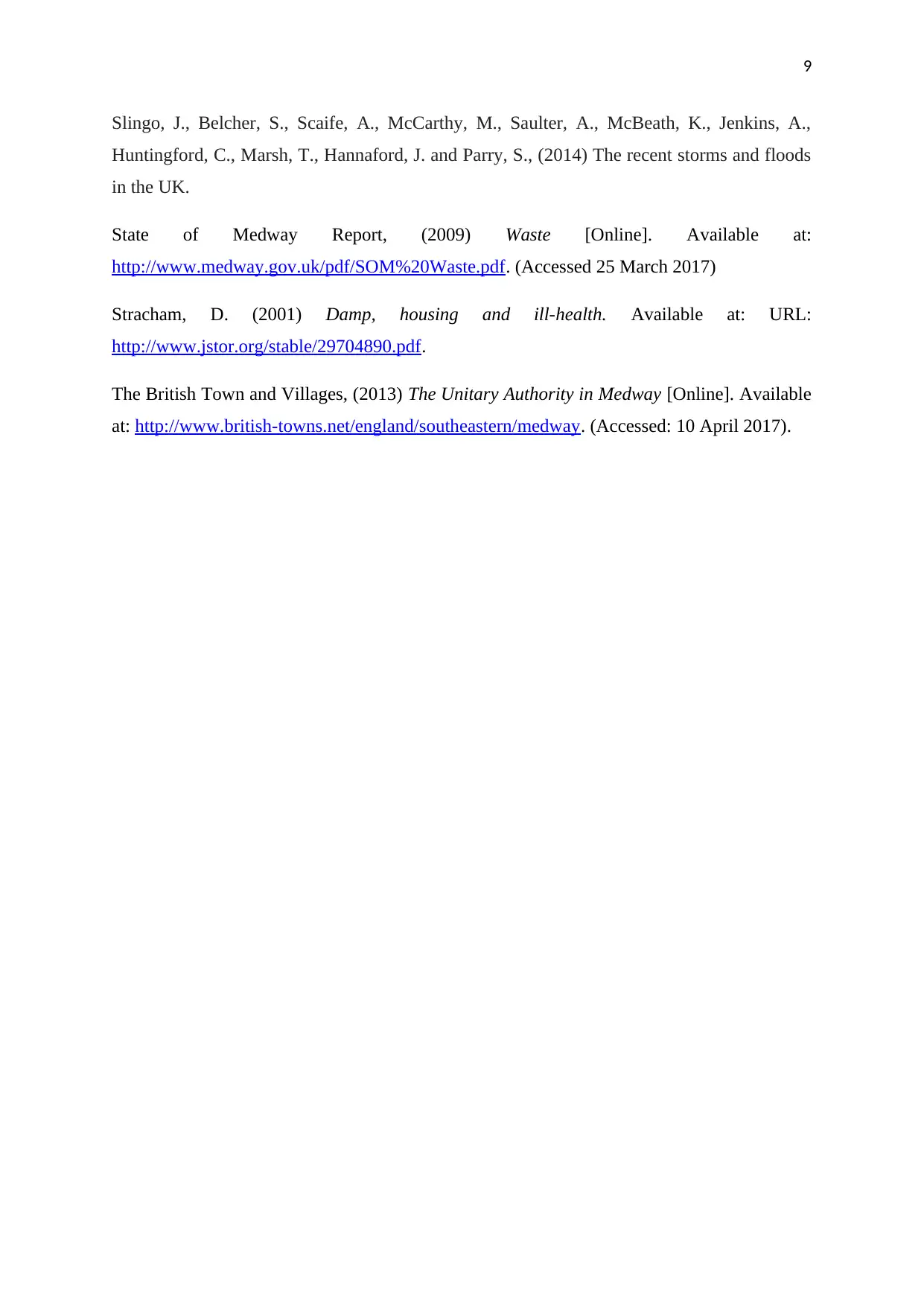
9
Slingo, J., Belcher, S., Scaife, A., McCarthy, M., Saulter, A., McBeath, K., Jenkins, A.,
Huntingford, C., Marsh, T., Hannaford, J. and Parry, S., (2014) The recent storms and floods
in the UK.
State of Medway Report, (2009) Waste [Online]. Available at:
http://www.medway.gov.uk/pdf/SOM%20Waste.pdf. (Accessed 25 March 2017)
Stracham, D. (2001) Damp, housing and ill-health. Available at: URL:
http://www.jstor.org/stable/29704890.pdf.
The British Town and Villages, (2013) The Unitary Authority in Medway [Online]. Available
at: http://www.british-towns.net/england/southeastern/medway. (Accessed: 10 April 2017).
Slingo, J., Belcher, S., Scaife, A., McCarthy, M., Saulter, A., McBeath, K., Jenkins, A.,
Huntingford, C., Marsh, T., Hannaford, J. and Parry, S., (2014) The recent storms and floods
in the UK.
State of Medway Report, (2009) Waste [Online]. Available at:
http://www.medway.gov.uk/pdf/SOM%20Waste.pdf. (Accessed 25 March 2017)
Stracham, D. (2001) Damp, housing and ill-health. Available at: URL:
http://www.jstor.org/stable/29704890.pdf.
The British Town and Villages, (2013) The Unitary Authority in Medway [Online]. Available
at: http://www.british-towns.net/england/southeastern/medway. (Accessed: 10 April 2017).
1 out of 10
Your All-in-One AI-Powered Toolkit for Academic Success.
+13062052269
info@desklib.com
Available 24*7 on WhatsApp / Email
![[object Object]](/_next/static/media/star-bottom.7253800d.svg)
Unlock your academic potential
© 2024 | Zucol Services PVT LTD | All rights reserved.